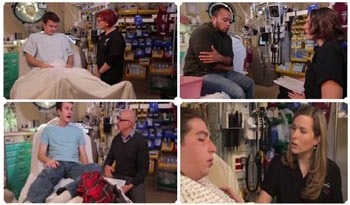Introduction
Emergency department (ED) clinicians are in a unique position to interact with people struggling with opioid addiction. Some ED clinicians will see the same patients in their emergency clinics multiple times, often after administering life saving naloxone to reverse an overdose. NIDA has funded research into the initiation of medications for opioid use disorder for addiction to opioids right there in the emergency setting, in collaboration with emergency department specialists at Yale University. The resources below were developed by emergency medicine and addiction medicine researchers. The views and opinions expressed in these resources are those of the authors only and do not necessarily represent the views, official policy or position of the U.S. Department of Health and Human Services or any of its affiliated institutions or agencies.

Why the Emergency Department (ED)?
That is Where the Patients Are! The opioid epidemic is strongly impacting EDs, with 2018 data from the CDC indicating that there has been a 30% increase in visits for opioid overdose from July 2016 – September 20171. Addiction is a chronic, relapsing disease, and a strongly stigmatized one. It is NOT a moral failing. People who present to the ED for other chronic disease like diabetes and asthma are stabilized with medications and handed off for outpatient care. Individuals with opioid use disorder (OUD) do best with a similar treatment plan.
What is the Evidence?
A 2015 study (JAMA) found that twice as many patients were in OUD treatment at 30 days (~80%) with ED-initiated buprenorphine & a brief negotiation interview (BNI) compared with referral only or a BNI + facilitated referral and used less illicit opioids in the last 7 days.2
What Do I Need to Know About Buprenorphine?
It is NOT simply replacing one drug for another. Buprenorphine treatment decreases withdrawal and craving. Patients who receive buprenorphine are less likely to overdose, die, use illicit opioids, or spread HCV or HIV and have fewer injection drug use complications and contacts with the criminal justice system.3
Since 2002, ED physicians have been able to administer buprenorphine in the ED for opioid withdrawal. Within 30-45 minutes patients will be much more comfortable. MDs, PAs, and APRNs can prescribe buprenorphine with referral to ongoing treatment. (A DATA waiver (X-waiver) is no longer needed to prescribe buprenorphine. Visit SAMHSA's website for more information about the removal of the DATA waiver requirement.
Buprenorphine is a partial agonist at the mu opioid receptor, where it has a very high affinity but low intrinsic activity. Its high affinity means it will out-compete and displace full opioid agonists. It is administered when the patient exhibits withdrawal symptoms (COWS > 8). Its low intrinsic activity results in less euphoria and lower diversion potential.
Motivating Patients

- Case 1 - Opioid Overdose: ED-Initiated Buprenorphine
- Case 2 - Seeking Treatment for Opioid Use Disorder
- Case 3 - Opioid Overdose: Harm Reduction
- Case 4 - Adolescent Presenting with Opioid Overdose: Assessment, Intervention and Referral
- Case 5 - Prescription Opioid Withdrawal Symptoms: Assessment, Treatment and Referral
Tools and Assessments
- Clinical Opioid Withdrawal Scale (COWS)
- Questions for Identification of Opioid Use Disorder based on DSM-5
Provider Resources
- ED-Initiated Buprenorphine (Yale School of Medicine)
- Words Matter Handout (PDF, 16KB)
- Ongoing Opioid Use Disorder Research
- Opioid Use Disorder in the Emergency Department: CTN 0069 (NIH ClinicalTrials.gov)
- Emergency Department Connection to Care With Buprenorphine for Opioid Use Disorder (ED-CONNECT) (NIH ClinicalTrials.gov)
- Feasibility of the Utilization of Buprenorphine in the Emergency Room to Treat Clinical Opioid Withdrawal (NIH ClinicalTrials.gov)
- ER/LA Opioid Surveillance for Emergency Department Visits and Hospitalizations for Overdose and Poisoning (NIH ClinicalTrials.gov)
Frequently Asked Questions (FAQs)
Heroes in Practice
Emergency physicians around the country have partnered with state entities to develop a spectrum of innovative strategies. These strategies entail increasing access to care, identifying those at high risk for overdose, safe prescribing, offering access to naloxone, sharing data among agencies, and decreasing stigma by recognizing not only that words matter, but accurate words matter. Some of these heroes are highlighted in the videos below describing what they are doing to combat the opioid epidemic. These resources were developed by emergency medicine and addiction medicine researchers. The views and opinions expressed in these resources are those of the authors only and do not necessarily represent the views, official policy or position of the U.S. Department of Health and Human Services or any of its affiliated institutions or agencies.
- Andrew Herring, MD; Highland Hospital, Oakland California
- Gail D’Onofrio MD, MS and Kathryn Hawk MD, MHS; Yale New Haven Hospital, New Haven, CT
- Rachel Haroz, MD; Cooper University Health Care, Camden NJ
- Ross Sullivan, MD; Upstate University Hospital, Syracuse NY
References
- Vivolo-Kantor AM, Seth P, Gladden RM, et al. Vital Signs: Trends in Emergency Department Visits for Suspected Opioid Overdoses — United States, July 2016–September 2017. MMWR Morb Mortal Wkly Rep 2018;67:279–285. DOI: http://dx.doi.org/10.15585/mmwr.mm6709e1.
- D’Onofrio, G., O’Connor, P.G., Pantalon, M.V., Chawarski, M.C., Busch, S.H., Owens, P.H., Bernstein, S.L. and Fiellin, D.A., 2015. Emergency department–initiated buprenorphine/naloxone treatment for opioid dependence: a randomized clinical trial. JAMA, 313(16), pp.1636-1644.
- Mattick RP, Breen C, Kimber J, Davoli M. Buprenorphine maintenance versus placebo or methadone maintenance for opioid dependence. Cochrane Database of Systematic Reviews 2014, Issue 2. Art. No.: CD002207. DOI: 10.1002/14651858.CD002207.pub4
